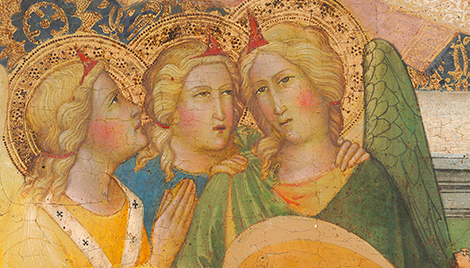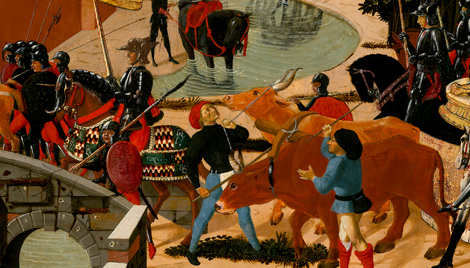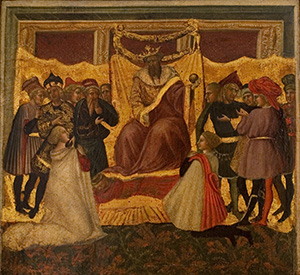Scene From a Novella (cassone panel)
Scene From a Novella (cassone panel)
- Artist
- Priamo della Quercia
- Artist Dates
- active 1438-after 1467
- Artist Nationality
- Italian
- Title
- Scene From a Novella (cassone panel)
- Date
- early 1440s
- Medium
- tempera and toolded gold on panel
- Dimensions
- 41.9 x 46.5 cm (17 x 18-1/4 in)
- K Number
- K269
- Repository
- Fairfield University Art Museum
- Accession Number
- 2009.01.03
- Notes
Provenance
Vatican, Rome; (Giulio Sterbini [d. 1911], Rome). (Count Alessandro Contini Bonacossi [1878-1955] Rome-Florence); sold to Samuel H. Kress [1863-1955] on 28 June 1933 as Andrea di Giusto; gift to the National Gallery of Art in 1939; deaccessioned in 1952 and returned to the Samuel H. Kress Foundation; gift 1962 to the Museum of Art, Science and Industry, Bridgeport, CT; gift 2002 to the Bellarmine Museum of Art, Fairfield University, no. K269..
Catalogue Entry
Priamo della Quercia
Scene From a Novella (cassone panel)
K269
Bridgeport, Conn., Museum of Art, Science and Industry, Study Collection, since 1961.(1) Wood. 17 X 18 1/4 in. (43.2 X 46.4 cm.). Much abraded. Formerly attributed to Andrea di Giusto, K269 is now generally believed to be Sienese, and more likely by Vecchietta, about 1450, than by Domenico di Bartolo, with whom it has also been associated.(2) K269 probably comes from a cassone, in the decoration of which it was associated with a panel of approximately the same height, but wider, in the Johnson Collection, Philadelphia Museum, there labeled Esther in the Temple, by Andrea di Giusto.(3) K269 also probably represents an episode from the story of Esther, rather than one from the Decameron.(4) The scene may be the Degradation of Haman, who lies prostrate before the throne, as in a drawing of the subject by Aert de Gelder.(5) Provenance: Vatican, Rome (?). Giulio Sterbini, Rome (catalogue by A. Venturi, 1906, no. 37A,(6) as Vecchietta). Contini Bonacossi, Florence. Kress acquisition, 1933 – exhibited: 'Italian Paintings Lent by Mr. Samuel H. Kress,' Jan. 1934, San Francisco, Calif, through June 1935, Charlotte, N.C., p. 15 of catalogue, as Andrea di Giusto; National Gallery of Art, Washington, D.C. (246), 1941-53.(7)
References
(1) Catalogue, n.d. (1962), p. unnumbered, as Andrea di Giusto. (2) K269 has been attributed to Andrea di Giusto by B. Berenson (in Dedalo, vol. XII, 1932, pp. 518 ff.; Pitture italiane del rinascimento, 1936, p. 11; but this and also its Philadelphia pendant are omitted from the 1963 edition of Berenson's Florentine lists, to be transferred to the Sienese section, where, I am informed, it will be included as Taddeo di Bartolo), G. Fiocco, R. van Marle, W. E. Suida, and A. Venturi (in ms. opinions). C. L. Ragghianti (in Critica d'Arte, Aug.-Dec. 1938, p. XXIII) attributes it to Domenico di Bartolo. R. Longhi (in Critica d'Arte, July -Dec. 1940, p. 183 n. 18) favors an attribution to Vecchietta, as does F. Zeri (in ms. opinion). J. Pope-Hennessy (in Burlington Magazine, vol. LXXXIV, 1944, p. 139) thinks the painting is Florentine rather than Sienese. (3) The Johnson painting is reproduced by Berenson in Dedalo, loc. cit. in note 2, above. (4) A Decameron source is suggested in the catalogue referred to in note 7, below. (5) Reproduced by H. Tietze, European Master Drawings, 1947, no. 75. (6) Reported as in an English edition, not available to me. (7) Preliminary Catalogue, 1941, pp. 4 f, as Andrea di Giusto.






